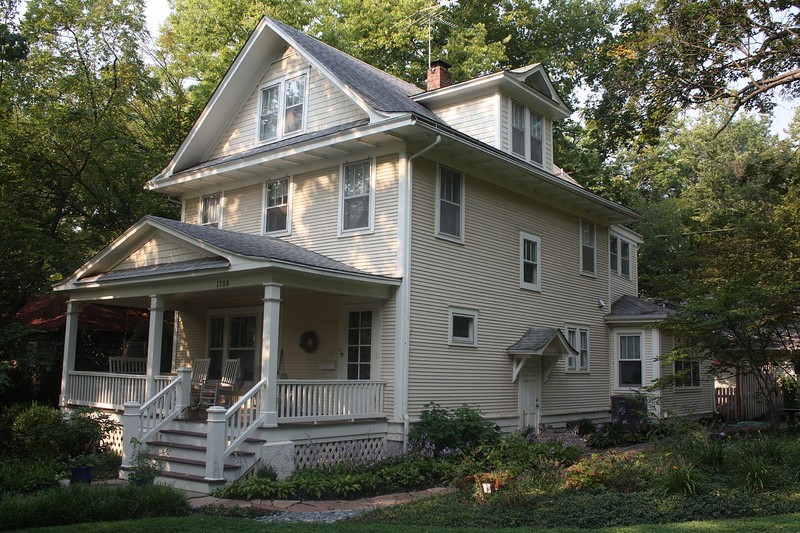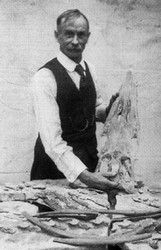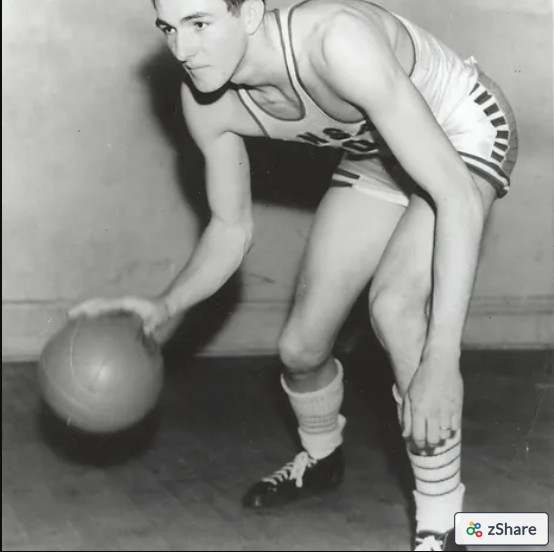Handel T. Martin House
Introduction
Text-to-speech Audio
Handel Tong Martin (1862-1931) worked at the University of Kansas and gained fame as an early fossil collector and contributor to the developing field of vertebrate paleontology. As his career progressed, he moved his family from a house in an older residential neighborhood west of downtown Lawrence to a new American Foursquare home built in 1916 in the developing subdivision of University Place, located just south of the University of Kansas campus. In the early 1960s, Charles Bradford Black, Jr (1921-1992), an outstanding KU and professional basketball player and a World War II (Army Air Corps) hero, owned the house.
Images
Handel T. Martin House

Handel T. Martin

Charles B. Black

Backstory and Context
Text-to-speech Audio
Martin immigrated to the United States from England and settled in Logan County, Kansas, in 1886. He came to the U.S. only possessing a "country school" education that ended at age thirteen. Still, Martin acquired a deep interest in the developing field of vertebrate paleontology. He became acquainted with fossils through his father and collected invertebrates in Wales along with a friend, a graduate in geology at the Aberystwyth College. Logan County had some of the richest Cretaceous fossil fields in the world. Martin collected fossils for Professor O.C. Marsh of Yale, who also served as director of the U.S. Geological Survey. Martin also collected independently and shipped fossils to all the leading museums in the country and Europe. Martin went to New York City in the winter of 1894 to work at the American Museum of Natural History in the laboratory of paleontology.
In 1895, Martin investigated a site significant to Native American history when he joined KU's T.R. Overton in excavating a prehistoric site at Twelve Mile Creek in Logan County, Kansas, considered the first systematically excavated Paleoindian site. Later radiocarbon techniques showed that Native Americans killed bison there about 10,300 years ago. As a result of the findings, the Twelve Mile Creek site now enjoys recognition as one of the most important to North American archaeology because it demonstrates that Native Americans lived in the North American continent much earlier than previously believed.
He began working at KU in 1896 as the chief assistant and preparator for Samuel Williston. After Williston left the University, Martin made important expeditions to South America, Oregon, the Oligocene and Miocene of Colorado, and the Eocene of Wyoming; his work could be found in several museums, including the Smithsonian and the London Museum of Natural History. During a year's leave of absence in 1903, Martin traveled in Patagonia, collecting fossils, which he sold to museums in Europe, American museums, and the University of Kansas collections.
Despite Martin's lack of formal education, his self-teaching, hard work, and determination enabled him to become KU's curator of fossil vertebrates, a position he held from 1912 until his death in 1931. Martin trained numerous students who went on to distinguished careers in the field during the twentieth century, and his work and collections helped KU gain a reputation as one of the nation's outstanding natural history museums.
As Martin advanced in his career, he moved his family from a house in an older residential neighborhood in West Lawrence (west of downtown) to the now-historic home in 1917 located in the developing subdivision of University Place located just south of the University of Kansas (KU) campus. Three other residents, Hazel, an assistant librarian at the university, Hattie, a nurse, and Harry, all boarded at the Martin home. And several other KU professors, students, and employees lived near the Martins. Indeed, KU evolved into one of Lawrence's chief economic drivers by the early twentieth century. By the time Martin moved into his now-historic home in 1917, the development of an expansive residential district south of Twelfth Street had demonstrated the significant trend in the growth of Lawrence south and west of downtown, near KU. In truth, plans to construct residential communities arose in 1887, but the idea did not come to fruition until 1910. But, by 1930, seventeen percent of the town's population was distributed south of Twelfth Street, west of Massachusetts Street, reflecting KU's impact on Lawrence.
Another notable resident of the historic home was Charles Bradford Black, Jr (1921-1992), an accomplished basketball player and World War II hero who lived there during the early 1960s. Black is the only four-time All-American in KU history, the first Jayhawk to be named all-conference four times, and the first to score 1,000 points in his career. During the last couple of years of World War II, Black served for the Army Air Corps, completing fifty-one missions as a reconnaissance pilot and was awarded the Distinguished Flying Cross. After the war, Black returned to KU, and Black then played professional basketball for five seasons—one year with the National Basketball League and four seasons with the Fort Wayne Pistons, Indianapolis Jets, and Milwaukee Hawks of the National Basketball Association.
Sources
"Charlie B. Black." Kansas Sports Hall of Fame. Accessed March 24, 2024. https://www.kshof.org/team/charlie-b.-black.
Nimz, Dale E. "Registration Form: Martin, Handel T. House." National Register of Historic Places. nps.gov. 2014. https://npgallery.nps.gov/GetAsset/b04cbf77-e279-484a-9781-f1d30905a8fe.
Rogers, Richard A., and Larry D. Martin. “The 12 Mile Creek Site: A Reinvestigation.” American Antiquity 49, no. 4 (1984): 757–64.
"University of Kansas." Kansas Historical Society. July 2014. https://www.kshs.org/kansapedia/university-of-kansas/18617#:~:text=University%20of%20Kansas,admit%20men%20and%20women%20equally.
By Andrew Johnston - Own work, CC BY-SA 4.0, https://commons.wikimedia.org/w/index.php?curid=62185774
Photo by Mike Everhart at findagrave.com: https://www.findagrave.com/memorial/9049830/handel-tong-martin
Kansas Sports Hall of Fame: https://www.kshof.org/team/charlie-b.-black
